|
⇐ Previous Article — Table of Contents — Next Article ⇒
New Energy Times home page
5. "Lucky Tweezers" — The LENR Null Results Laboratory, Again
By Steven B. Krivit
Introduction
According to research scientist David Kidwell and his colleagues at the Naval Research Laboratory, the transmutation claims made by LENR researchers at Mitsubishi Heavy Industries in Japan may be the result of an MHI researcher who is no longer employed there who contaminated the experiment with "lucky tweezers."
NRL/Kidwell's Attempt at ICCF-15 to Discredit LENR Transmutation
In his presentation in Rome at ICCF-15, Kidwell attempted to convince the audience that the Mitsubishi/Iwamura observation of a growth of praseodymium was the result of one of two hypothetical scenarios. In the first of Kidwell's scenarios, an ex-Mitsubishi researcher used "‘lucky’ tweezers" contaminated with praseodymium that fooled the Mitsubishi researchers into thinking they had observed LENR transmutation. Kidwell did not explain how the praseodymium got on the tweezers. Kidwell effectively suggested the possibility of intentional spiking – that is, science fraud.

(Source: Kidwell's ICCF-15 Slides)
In his second two-part hypothetical scenario, the praseodymium was first deposited on the multilayered surface while it was in the mass balance and subsequently became buried beneath the fabricated layers. The second part of this scenario is that, during the experiment, the praseodymium preferentially migrated up to the surface.
Kidwell did not explain how, when or why the praseodymium allegedly got into the mass balance in all of the experiments that Mitsubishi ran within the last decade and why such contamination occurred only when they were weighing the experimental samples, not the control samples. Kidwell did, however, find that praseodymium was on the walls of the mass balance when he was at the Mitsubishi lab in Japan on the last day of his 10-day site visit.
According to Kidwell, this second scenario explains why the researchers failed to detect the praseodymium at the beginning of the experiment and were fooled into thinking they had created the praseodymium from LENR transmutation.

(Source: Kidwell's ICCF-15 Slides)
If Kidwell had any clear evidence for either one of theses scenarios, he wouldn't need to speculate.
Failure to Replicate
Before Kidwell developed his scenarios, an NRL team had attempted to replicate the Mitsubishi LENR transmutation experiment and results. According to another NRL researcher, Kenneth Grabowski, NRL failed to replicate the Mitsubishi results despite—allegedly—precisely replicating the experiment. The multiyear replication program by NRL is rumored to have cost millions. In addition to receiving some funding from the Defense Threat Reduction Agency, the project received the bulk of the funding from the Defense Advanced Research Projects Agency.
The NRL team was directly managed by Grabowski, controlled by Michael Melich* (a former NRL laboratory head who is now at the Naval Postgraduate School), and funded under the authority of Graham Hubler, head of the Sensor Materials Branch.
| 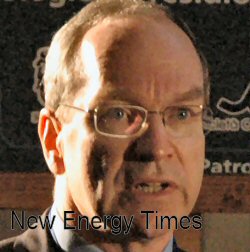
Kenneth Grabowski
Photo: S. B. Krivit |
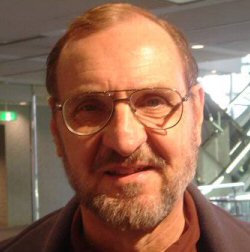
Michael Melich
Photo: W. Collis |
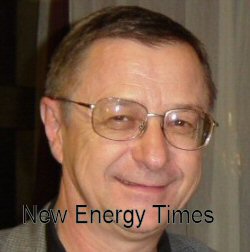
Graham Hubler
Photo: S. B. Krivit |
Other participants were NRL researchers Kidwell, David Knies, Catalina Cetina and Carmine Carosella.
After NRL failed to replicate the results, it collaborated with Mitsubishi to perform replications. NRL again came back empty-handed: null results. It was then – "on a whim," according to Kidwell – that he decided to perform an "environmental survey" in the Mitsubishi laboratory. Kidwell swiped about 25 locations around the lab, came back to the U.S. and analyzed his swipes. He found high levels of praseodymium from the swipes he took from inside the mass balance at the Mitsubishi lab.
The smoking gun of environmental contamination, right? Not so fast..
First, let's learn some of the nuts and bolts of the Iwamura experiment.
The Mitsubishi/Iwamura LENR Gas Permeation Experiment
Readers who are familiar with the Iwamura experiment may wish to skip this section and proceed directly to the section "Assessing the Credibility of NRL/Kidwell's Attempt to Discredit the Mitsubishi Work."
The essential part of the experiment is a multilayered substrate of palladium and calcium oxide. On the surface of the substrate, the Mitsubishi researchers place atoms from a given element. Deuterium gas is passed through the substrate. As the experiment progresses, the given element is seen to decrease in quantity, and an element which was not present before the experiment slowly appears on the surface and increases in quantity.
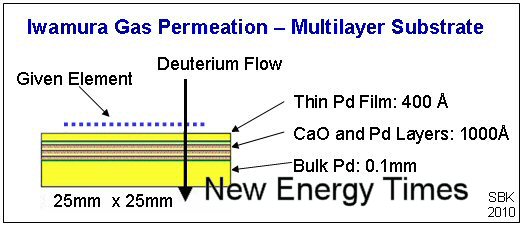
|
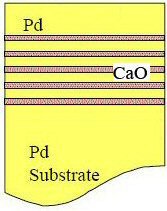
|
|
Left: Conceptual view of multilayered substrate.
Right: Detailed view of multilayer fabrication—Five layers each of Pd followed by CaO,
finished with final layer of Pd.
Image credit: Mitsubishi Heavy Industries |
The multilayered substrate is assembled and mounted on top of a set of small holes through which the D2 passes.
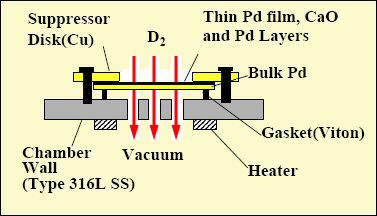
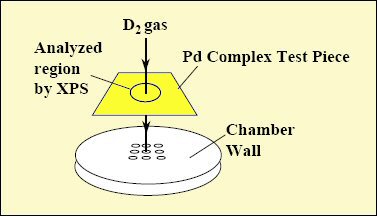
Multilayered Substrate Assembly
Image credits: Mitsubishi Heavy Industries
The multilayered substrate assembly (yellow) is mounted at the intersection of two evacuated chambers: Chamber A (blue) and Chamber B (green).
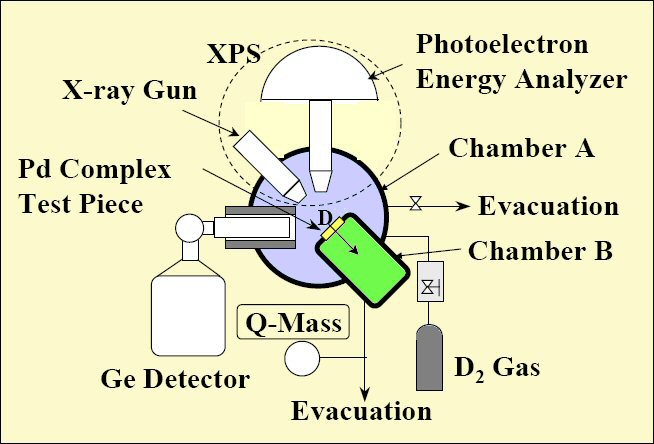
Deuterium Gas Permeation Apparatus Schematic
Image credit: Mitsubishi Heavy Industries
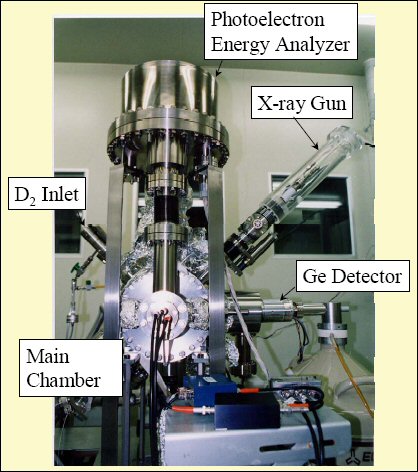
Deuterium Gas Permeation Apparatus
Photo credit: Mitsubishi Heavy Industries
How It Works
Chambers A and B are evacuated, then chamber A is filled with D2 gas and Chamber B is evacuated to 3x10-8 Torr with a turbomolecular pump. Over a period of a week or two, depending on the target materials, the Mitsubishi researchers observe a gradual increase in the number of target atoms, for example praseodymium, as well as the simultaneous gradual decrease of given atoms, for example cesium.
The researchers observe atomic changes with X-ray photoelectron spectroscopy (XPS) in real time, while the experiment is in process and sealed. They explain the advantage of this method in their 2002 peer-reviewed journal article.[1]
"Almost all the other researchers in this field are conducting experiments involving the electrolysis of D2O or H2O with metal as a cathode and they usually analyze the transmuted products on the cathode metal by taking it out of the experimental apparatus after electrolysis," the researchers write. "Our experimental method described above is superior in that it discriminates the products from contamination because we analyze the products in vacuum during the experiments without moving the products."
Just before starting the permeation, with the chambers sealed, they test to make sure that no other elements are on the surface of the multilayered substrate except the given element (for example, cesium or strontium) and the palladium and calcium oxide that is present on the substrate.
In the work with cesium ⇒ praseodymium, for example, no praseodymium is present on the surface of the multilayered substrate at the beginning of the experiment, as shown by the in-situ XPS measurements.
Once the experiment begins, the Mitsubishi researchers stop the deuterium gas flow periodically to perform the XPS measurements. They run the deuterium gas permeation from two days to a week, then evacuate the deuterium from chamber A and perform the XPS analysis on the surface of the palladium substrate. They usually do this a few times over the course of the experiment to observe the time dependency of the given as well as newly created elements.
Some of Mitsubishi's Results and Analytical Methods
Below is an example of some of the Mitsubishi results, reported in Mitsubishi's 2002 paper, that shows two pairs of measurements: The first pair was measured at time-zero, at 49 hours and at 120 hours.
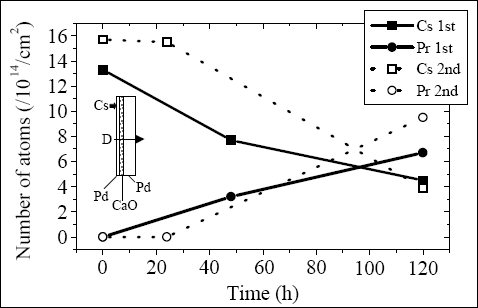
Two experimental runs showing temporally correlated gradual decrease of cesium and increase of praseodymium
Image credit: Mitsubishi Heavy Industries
They have repeated this type of observation many times, with several pairs of elements:
133Cs ⇒ 141Pr (addition of 4 deuterons)
88Sr ⇒ 96Mo (addition of 4 deuterons)
137Ba ⇒ 149Sm (addition of 6 deuterons)
44Ca ⇒ 48Ti (addition of 2 deuterons)
The gradual increase of one element and the temporally correlated gradual decrease of another element are consistent features of their experiment. As shown below, their XPS data create a similar pattern among three sets of experimental runs. Again, the gradual, temporal signature of growth and reduction is crystal clear.
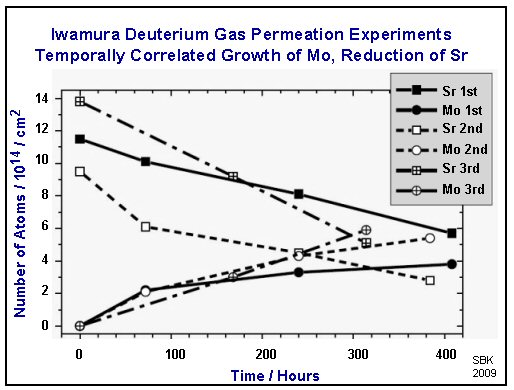
The researchers went further than just the in-situ XPS measurements. The stable transmutation products provided permanent evidence, unlike the ephemeral excess-heat from Fleischmann-Pons experiments. Mitsubishi sent its samples out for a secondary analysis to Probion Analysis, Inc., an independent laboratory in France, for secondary ion mass spectrometry (SIMS).
The Mitsubishi researchers explained SIMS: "[SIMS is] a surface analysis technique in which energetic primary ions impact the surface and generate secondary ions, which are subsequently mass-separated and detected. SIMS is capable of analyzing all the elements with isotopic discrimination."
In their set of experiments with strontium as the given element and molybdenum as the target element, they saw very clear results of apparent LENR transmutation: unexpected isotopic abundances. The differences are shown below.
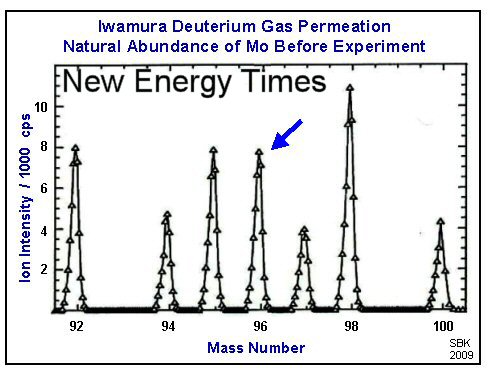
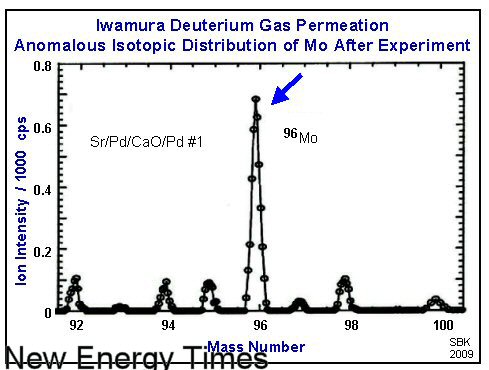
The Mitsubishi researchers went further still. They brought their experimental apparatus to the Spring-8 synchrotron radiation facility in Harima, Japan, and used Synchrotron Orbit Radiation X-Ray (SORX) analysis with yet a third method to confirm the transmutation process, again, in situ. Here is the schematic, again showing the multilayered substrate assembly (yellow), chamber A (blue) and chamber B (green).
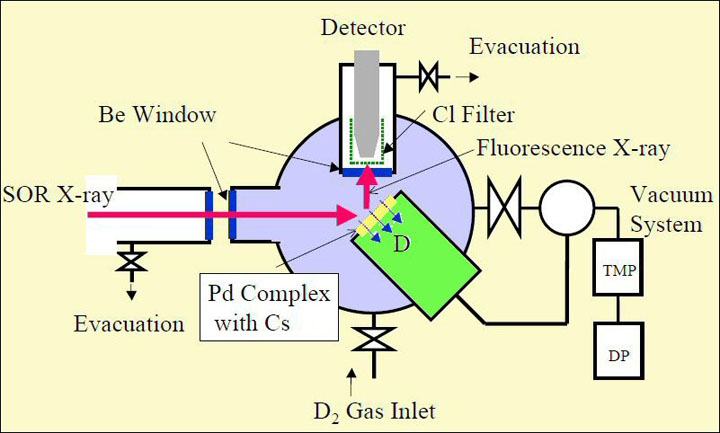
SORX Apparatus Schematic
Image credit: Mitsubishi Heavy Industries
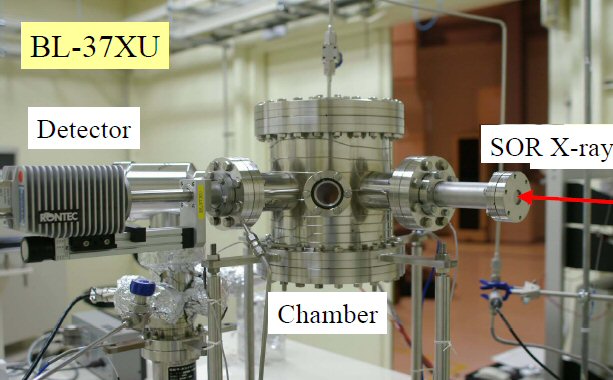
SORX Apparatus Schematic
Photo credit: Mitsubishi Heavy Industries
Assessing the Credibility of NRL/Kidwell's Attempt to Discredit the Mitsubishi Work
Now it is time to scrutinize Kidwell's hypothetical scenarios in which he attempts to explain away the Mitsubishi LENR transmutation results. Considering the well-controlled and meticulously designed experiment, how, according to Kidwell, is it possible that the experiment got "contaminated"? Let's first look at the "Lucky Tweezers" scenario.
In this scenario, an ex-Mitsubishi researcher used "lucky tweezers" contaminated with praseodymium when extracting the sample after the experiment, and this is what fooled the Mitsubishi researchers into thinking they had observed LENR transmutation.
Aside from the unanswered and potentially volatile question of how praseodymium might have gotten onto the lucky tweezers, this scenario has two major problems. One is that, during the experiment, praseodymium gradually increases over time. The second is that, in a nearly linear relationship, cesium decreases gradually during the course of the experiment.
Now consider Kidwell's second scenario.
The crucial scene takes place in the balance used to measure the mass of the substrate before it enters the chambers. We're talking about a device that looks like this:
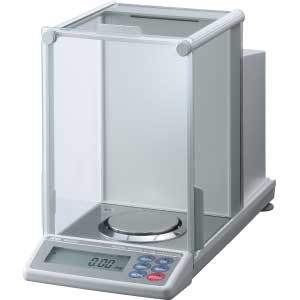
Scientific Mass Balance
This scenario requires that traces of praseodymium were present inside the mass balance at the time of the sample fabrication. It requires that praseodymium fall from the wall of the balance onto the substrate during the build. In Kidwell's words, "contamination from dust in balance contaminates the interior of the multi-layer structure with small particles of praseodymium."
Exactly how does Kidwell explain that praseodymium from the balance contaminated the interior of the multilayered substrate? He doesn't. We have Iwamura to thank for providing a precise explanation of Kidwell's scenario.
The following New Energy Times diagram is based on Iwamura's diagram presented at ICCF-15. As Iwamura explained, if the praseodymium contaminated the multilayered substrate in the balance, it would have to fall or be placed on top of the palladium substrate and below the layers of palladium and CaO which are sputtered on in step four. The substrate is put into the balance twice during the fabrication process. The following diagram displays these steps in detail (click image to enlarge).
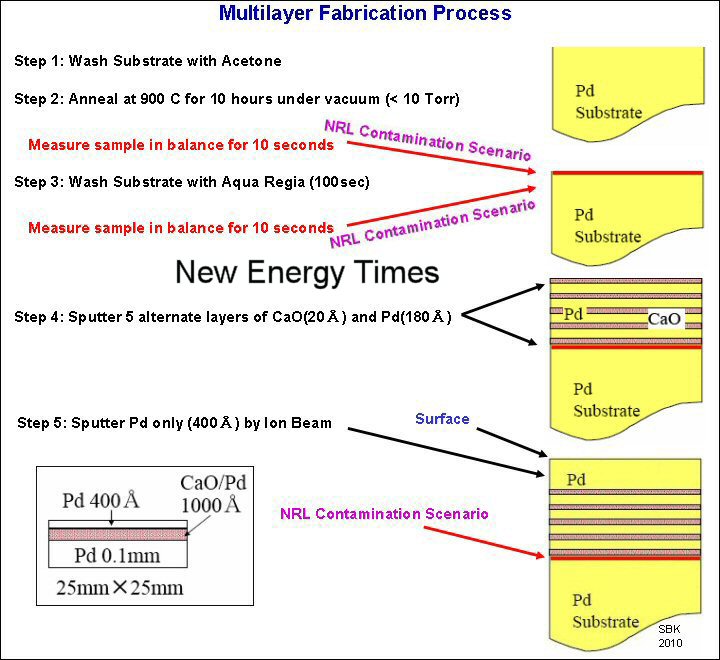
Once fabricated, the substrate looks like this, as viewed through a field emission transmission electron microscope.
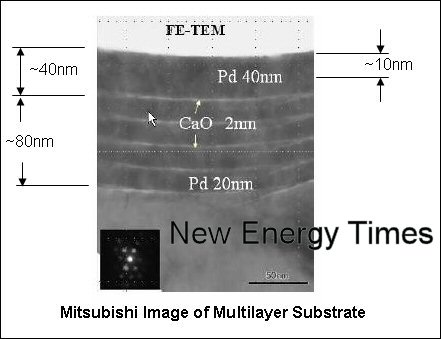
Image of Multilayered Substrate
Photo credit: Mitsubishi Heavy Industries
Now, one more major step needs to occur in the Kidwell scenario. The praseodymium must come up through the multiple layers and reach the surface of the multilayered substrate. And the praseodymium must rise from the palladium substrate while the deuterium gas is flowing down into and through the substrate. Similarly, Kidwell had speculated that, in the Arata-Zhang experiment, solid silver preferentially migrated through solid palladium in the opposite direction of the gas pressure (see "NRL 2008-The LENR Null Results Laboratory" in this report).
Assuming that Kidwell can explain how praseodymium can flow in the opposite direction of the deuterium gas, what is the evidence that praseodymium, in fact, exists below the surface? According to Iwamura's tests, praseodymium does not appear in the post-experiment sample below 10nm from the surface. This means that either there is no
praseodymium below the surface, or, if there was, it would have had to travel about 100nm up to the surface – all of it.
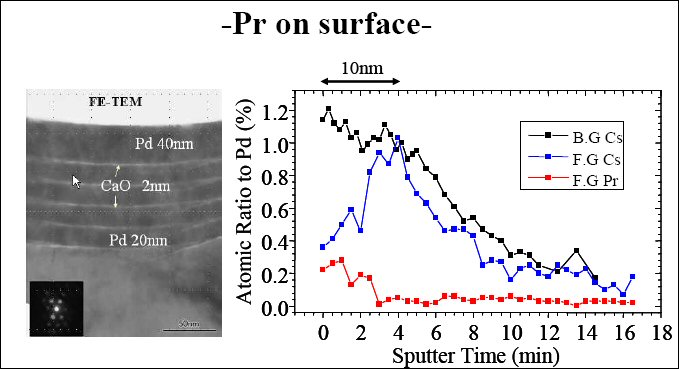
Depth Profile of Praseodymium on Surface
Image credit: Mitsubishi Heavy Industries
Iwamura also showed that the praseodymium appears in high concentrations in localized spots on the surface. This finding contradicts Kidwell's speculation that "praseodymium migrates to [the] surface under [the] influence of the deuterium flux [and] spreads as [it] migrates."
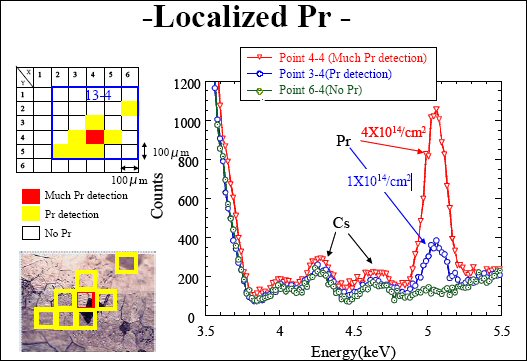
Topographical Profile of Praseodymium on Surface
Image credit: Mitsubishi Heavy Industries
Iwamura made several other points in his rebuttal to Kidwell (Audio, Slides, Transcript), including the most fundamental for any science experiment, the results of Mitsubishi's control experiments.
"For foreground experiments, we have positive praseodymium," Iwamura said. "But if we have only cesium and no [deuterium gas] permeation, we never get praseodymium. Also, [if we] only use [deuterium gas] permeation without cesium, we have no praseodymium for six cases ... So I can't understand why, if praseodymium originated from the balance contamination, then praseodymium should have been detected every time."
After Kidwell's public presentation in Rome, New Energy Times asked Kidwell whether he could explain the temporally correlated decrease of cesium with any of his hypothetical scenarios. He started to respond, but Grabowski interrupted the conversation, instructed Kidwell to stop talking and referred New Energy Times to the Navy's office of public affairs.
|
Summary of Scientific Problems With the NRL/Kidwell Hypothetical Scenarios
- There are multiple replications of the Iwamura-type experiment at other Japanese and Chinese laboratories.
-
Mitsubishi/Iwamura have demonstrated the effect with a variety of element pairs, not just cesium and praseodymium.
-
NRL/Kidwell's first hypothetical scenario fails to explain the gradual increase of praseodymium.
-
NRL/Kidwell's second hypothetical scenario fails to suggest an explanation for the simultaneous and gradual decrease of cesium.
-
Mitsubishi/Iwamura have shown isotopic shifts.
-
Mitsubishi/Iwamura have used three analytical methods.
-
The "contamination dust" would have to have fallen or be placed on all of the substrates during two 10-second periods for each substrate.
-
The praseodymium "contamination" would have to flow in the opposite direction of the gas flow. Electrochemical cathodic deposition is not even a question; there is no electrolysis in this system.
-
No praseodymium is present in the completed samples below 10nm from the surface.
-
The praseodymium "contamination" flow would have to travel about 100nm up to the surface.
-
All of the praseodymium "contamination" would have to travel to the surface.
-
The praseodymium "contamination" flow would have to rise to the surface and either remain localized through the journey or re-concentrate on the surface into small, localized spots.
-
Mitsubishi/Iwamura's control experiments show what is expected from a control, each and every time.
|
The NRL-Mitsubishi Collaboration
In preparation for this article, New Energy Times sent queries to Hubler, Grabowski and Iwamura to confirm details of the collaboration timeline. Only Iwamura responded. Below, we compare Iwamura's timeline with a slide from Grabowski's presentation in October 2009 in Rome showing his reporting of key events in the collaboration.
Timeline According to Iwamura
| 2002 |
Grabowski first visits Mitsubishi lab. |
| 2002-2003 |
NRL attempts to independently replicate Mitsubishi and fails to find praseodymium. |
| April 2003 |
Joint research begins. Mitsubishi provides post-experiment samples, NRL confirms praseodymium. |
| May 2005 |
Phase 2 of collaboration begins. Grabowski + two visit
Mitsubishi, learn and observe successful experiment.
|
| > May 2005 |
Takasago, Toray and NRL labs confirm successful praseodymium results. |
| Fall 2005 |
Kidwell attempts and fails to detect praseodymium from other portion of May 2005 sample. |
| July 2006 |
Grabowski, Kidwell + one visit Mitsubishi and observe experiment; null results obtained. |
| July 19, 2006 |
Kidwell performs environmental survey. |
| > July 2006 |
Grabowski informs Iwamura of "environmental contamination." |
Key Events According to Grabowski
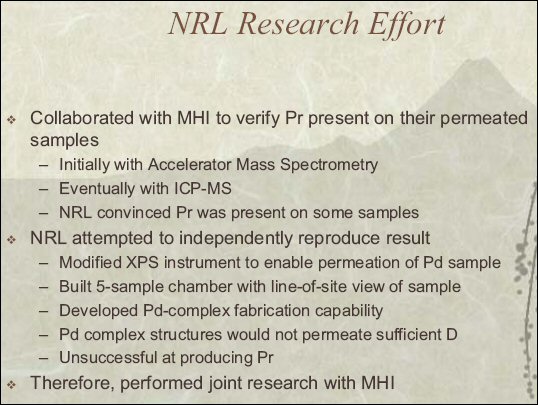
(Source: Grabowski's ICCF-15 Slides)
Iwamura explained to New Energy Times that origins of the replication project began in 2002 when Grabowski first visited the Mitsubishi lab.
Sometime in 2002 or 2003, according to Iwamura, NRL attempted to replicate the Mitsubishi experiment on its own. After much expended effort and time, as Grabowski claimed, the researchers failed to obtain positive results.
"In April 2003, the collaboration started under an agreement," Iwamura wrote. "We provided our samples, and they detected praseodymium from our sample."
That is correct. NRL confirmed the presence of praseodymium from a Mitsubishi LENR transmutation sample. Grabowski also states this in the slide shown above.
In May 2005, according to Iwamura, the second phase of collaboration began.
"Grabowski and two other NRL members visited us and learned how to conduct the experiment," Iwamura wrote. "NRL members and we performed experiments with them. We obtained praseodymium from permeated samples. Kidwell did not come to Japan at this time."
Iwamura told New Energy Times that Mitsubishi sent the samples to two Japanese labs for outside testing; they confirmed the presence of praseodymium. After that, Mitsubishi sent the samples to NRL, and Kidwell also confirmed the presence of praseodymium by inductively coupled plasma mass spectrometry (ICP-MS), as Iwamura was told by Grabowski.
A November 2005 e-mail to New Energy Times from Chase Peterson, with whom Melich maintains regular contact, also confirmed the positive result at Mitsubishi.
"Mike Melich confirms the confirmatory work in two labs in this country of the transmutation work that came out of Japan," Peterson wrote.
Sometime in the fall of 2005, according to Iwamura, Kidwell attempted and failed to detect praseodymium from the other portion of the May 2005 sample. The May 2005 sample had been sectioned into multiple parts. Conflict developed.
"Kidwell insisted that it was difficult to think that praseodymium would appear on one part but not from the other part," Iwamura wrote. "I insisted that it was caused by non-uniformity of praseodymium production; it is not unnatural that praseodymium appears on one part but not from another part."
The following year, from July 10 to July 19, 2006, according to Iwamura, Kidwell, Grabowski and one other person from NRL visited the Mitsubishi lab and observed experiments. Grabowski and the other person stayed an extra day.
"To my great surprise," Iwamura wrote, "on the 19th, Kidwell suddenly requested permission from me to perform environmental swipes. Making swipes was not part of our plan, but I permitted him to perform an environmental survey as I have confidence that our lab is clean. Kidwell wiped everywhere and took the swipe papers.
"After he came back to NRL, Kidwell performed ICP-MS analysis, and Grabowski informed us that our balance was contaminated by praseodymium. It was unbelievable, for we have never used praseodymium as a reagent in our clean room!"
Kidwell's slide #14 states that he performed the environmental survey on a "whim." Considering the difficulties NRL had in obtaining positive results, the fact that Kidwell fully expected to find contamination (that's what he said in his talk) and the fact that the main thrust of Kidwell's 2008 ICCF-14 presentation was about the propensity for environmental contamination, Kidwell’s suggestion that his environmental survey was not planned is surprising.
After Mitsubishi heard that Kidwell had found praseodymium in the inner wall of its balance, Mitsubishi also performed swipes and sent them out for analysis in Japan. They, too, came back positive. Mitsubishi promptly removed the contaminated balance from its clean room and brought in a new one.
"We investigated when and why our balance was contaminated," Iwamura wrote, "but it is still unclear how our balance got contaminated. Anyway, even if the inner wall of the balance was contaminated by praseodymium, the experimental results cannot be explained by the praseodymium contamination."
New Energy Times had attempted to get this story for several years, but both NRL and MHI kept a tight lid on it until now.
In August 2008, New Energy Times spoke with Iwamura and asked whether he could shed light on both NRL's confirmation of the Mitsubishi result and NRL's attempt to perform its own replication.
"They didn't do a precise replication," Iwamura said. "They didn't have suitable equipment."
Iwamura declined to provide explicit details at that time.
"They stopped the work," Iwamura said.
It was only at the October 2009 ICCF-15 conference in Rome, Italy, that both sides began to present their sides of the story more fully.
In Rome, NRL was given 22 minutes and an official slot on the program to explain its side. Iwamura was provided five minutes between NRL and the next speaker to provide his rebuttal; Iwamura's rebuttal was not listed on the official program. The session chairman openly encouraged the conference leaders to include Iwamura's slides in the proceedings. They did not immediately respond.
In Grabowski's presentation at the Army Research Laboratory LENR workshop on June 29, 2010, in Adelphi, Maryland, he told the Army that NRL found nothing and that Mitsubishi's results were the result of environmental contamination.
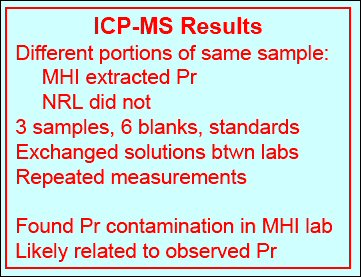
Kidwell "Goes the Extra Mile"
Last but not least in this international science drama are the comments from longtime LENR critic Kirk Shanahan, a research scientist with the defense programs technology section at the Savannah River National Laboratory. Shanahan did not attend the ICCF-15 meeting in Rome. He informed the Wikipedia editors in September 2009 that "contamination [is] the cause of 'new' heavy metals."
"In what may be another excellent effort," Shanahan wrote, "D. Kidwell and coworkers have ‘gone the extra mile’ and discovered that the claimed production of praseodymium in deuterium flow through palladium membrane experiments may well be due to contamination."
* Three people, Yasuhiro Iwamura, Graham Hubler, and Chase Peterson, former president of the University of Utah, identified Michael Melich as the person in charge of the NRL Mitsubishi replication project.
Reference
1. Iwamura, Y., Sakano, M., and Itoh, T., "Elemental Analysis of Pd Complexes: Effects of D2 Gas Permeation," Japanese Journal of Applied Physics A, Vol. 41, p. 4642, (2002)
⇐ Previous Article — Table of Contents — Next Article ⇒ | 
